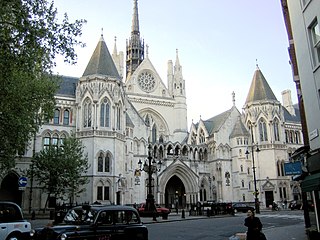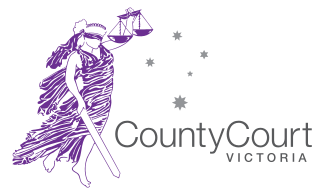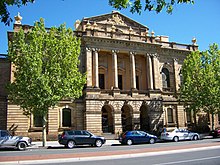
The Court of Appeal is the highest court within the Senior Courts of England and Wales, and second in the legal system of England and Wales only to the Supreme Court of the United Kingdom. The Court of Appeal was created in 1875, and today comprises 39 Lord Justices of Appeal and Lady Justices of Appeal.
The courts of England and Wales, supported administratively by His Majesty's Courts and Tribunals Service, are the civil and criminal courts responsible for the administration of justice in England and Wales.
In common law systems, a superior court is a court of general jurisdiction over civil and criminal legal cases. A superior court is "superior" in relation to a court with limited jurisdiction, which is restricted to civil cases involving monetary amounts with a specific limit, or criminal cases involving offenses of a less serious nature. A superior court may hear appeals from lower courts. For courts of general jurisdiction in civil law system, see ordinary court.

The Supreme Court of British Columbia is the superior trial court for the province of British Columbia, Canada. The Court hears civil and criminal law cases as well as appeals from the Provincial Court of British Columbia. There are 90 judicial positions on the Court in addition to supernumerary judges, making for a grand total of 108 judges. There are also 13 Supreme Court masters who hear and dispose of a wide variety of applications in chambers.

The Supreme Court of New South Wales is the highest state court of the Australian State of New South Wales. It has unlimited jurisdiction within the state in civil matters, and hears the most serious criminal matters. Whilst the Supreme Court is the highest New South Wales court in the Australian court hierarchy, an appeal by special leave can be made to the High Court of Australia.

The Supreme Court of Queensland is the highest court in the Australian State of Queensland. It was formerly the Brisbane Supreme Court, in the colony of Queensland.

The Supreme Court of Tasmania is the highest State court in the Australian State of Tasmania. In the Australian court hierarchy, the Supreme Court of Tasmania is in the middle level, with both an appellate jurisdiction over lower courts, and decisions made by Court to be heard on appeal by the High Court of Australia.

The Supreme Court of the Australian Capital Territory is the highest court of the Australian Capital Territory (ACT). It has unlimited jurisdiction within the territory in civil matters and hears the most serious criminal matters.

The Supreme Court of Singapore is a set of courts in Singapore, comprising the Court of Appeal and the High Court. It hears both civil and criminal matters. The Court of Appeal hears both civil and criminal appeals from the High Court. The Court of Appeal may also decide a point of law reserved for its decision by the High Court, as well as any point of law of public interest arising in the course of an appeal from a court subordinate to the High Court, which has been reserved by the High Court for decision of the Court of Appeal.

The County Court of Victoria is the intermediate court in the Australian state of Victoria. It is equivalent to district courts in the other states.

The High Court of Singapore is the lower division of the Supreme Court of Singapore, the upper division being the Court of Appeal. The High Court consists of the chief justice and the judges of the High Court. Judicial Commissioners are often appointed to assist with the Court's caseload. There are two specialist commercial courts, the Admiralty Court and the Intellectual Property Court, and a number of judges are designated to hear arbitration-related matters. In 2015, the Singapore International Commercial Court was established as part of the Supreme Court of Singapore, and is a division of the High Court. The other divisions of the high court are the General Division, the Appellate Division, and the Family Division. The seat of the High Court is the Supreme Court Building.

The Supreme Court of Norfolk Island is the superior court for the Australian territory of Norfolk Island. It has unlimited jurisdiction within the territory in civil matters and hears the most serious criminal matters. It also has jurisdiction over the Coral Sea Islands Territory. All matters are heard before a single judge, including appeals from the Court of Petty Sessions. In the Australian court hierarchy, it is one of eight state and territory Supreme Courts having unlimited jurisdiction in their respective parts of Australia. Appeal lies to the Federal Court of Australia, from which an appeal by special leave can be made to the High Court of Australia.

Sir John William Jeffcott was the first judge of the Supreme Court of South Australia. He also served as Chief Justice of Sierra Leone.
Henry Jickling was appointed as a caretaker judge in 1837 to the Supreme Court of South Australia, which is the highest ranking court in the Australian State of South Australia.

The District Court of Queensland(QDC) is the second tier in the court hierarchy of Queensland, Australia. The Court deals with serious criminal offences such as rape, armed robbery and fraud. Juries are used to decide if defendants are guilty or not guilty.
The Judiciary of Vermont is the state court system of Vermont, charged with Vermont law.

The courts of South Africa are the civil and criminal courts responsible for the administration of justice in South Africa. They apply the law of South Africa and are established under the Constitution of South Africa or under Acts of the Parliament of South Africa.

The Supreme Court of New South Wales for the District of Port Phillip was an historical division of the Supreme Court of New South Wales, exercising the jurisdiction of that court within the Port Phillip District of New South Wales. It consisted of a single Resident Judge. It existed from 1840 until 1852, when, following the separation of the Port Phillip District to form the Colony of Victoria, it was replaced by the Supreme Court of Victoria.

The High Court of Justice in London, known properly as His Majesty's High Court of Justice in England, together with the Court of Appeal and the Crown Court, are the Senior Courts of England and Wales. Its name is abbreviated as EWHC for legal citation purposes.

The King's Bench Division of the High Court of Justice deals with a wide range of common law cases and has supervisory responsibility over certain lower courts.
















